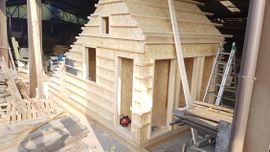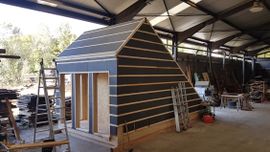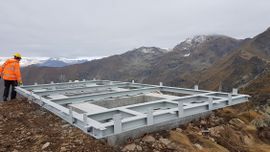Bivacco Punta Rama
Aus Smart Places Network
Version vom 10. Dezember 2020, 16:49 Uhr von Strohmeier (Diskussion | Beiträge) (Die Seite wurde neu angelegt: „{{Standort |Standort= Italien 10089 Frassinetto |Kategorie= Best practice examples }} {{Gallerie Element |Bild=Punta Rama-1.jpg }} {{Gallerie Element |Bild=Pun…“)
| Principal | capofila del progetto Comune di BORGIALLO | |
|---|---|---|
| Address | Punta Rama nel comune di Frassinetto | |
| Energy planning | ||
| year fo finalisation | 2018 - 2019 | |
| Construction costs € brutto | 85.000 | |
| Base area[m²] | ||
| Useful area[m²] | ||
| Cubage [m³] | ||
| Heating demand [kWh/(m²BGFa] | ||
| Heatingsystem | ||
| Technical data other object types | ||
| Project description | The construction of the bivouac is an integral part of a broader project for the valorisation of the tourist offer connected to outdoor activities and the improvement of the existing tourist infrastructure. The bivouac is the terminal point of the "Cresta Beltrando" itinerary. | |
| Construction material timber | Lhe structure of the bivouac was built using a frame system specially designed and dimensioned to withstand the mechanical stresses experienced by the structure in these extreme conditions. The structure is subjected to significant snow loads (we are at 2500m above sea level) and to stress from gusts of wind due to exposure on four sides (the structure is installed on the summit of Mount Rama). The load-bearing structure of the walls and roofs is made of poplar laminate frames braced with double panels of poplar OSB3. All interior panelling is made of poplar fir and larch wood. The end walls and doors are made of heat-treated laminated ash. All the timber used in the construction comes from the wood industry in the province of Turin. About 10 m3 of timber from a controlled supply chain was used. | |
| Planning | 1) Survey of the laying conditions 2) Architectural and functional study of the structure 3) Engineering study and dimensioning of the structure, connections and modularity of the structure for transport by helicopter at height 4) Implementation of the construction plans | |
| Construction processing | 1) Construction of poplar laminated elements for the construction of the frames 2) Construction of walls and horizontal frame structures with insertion of the coi- bentation inside the double OSB panels 3) Assembly of the walls and roofs in the workshop 4) Construction of the external cladding in stapled aluminium sheets and of the windows and doors in thermo-treated ash laminated panels 5) Construction of the internal cladding and furnishings 6) Construction of the electrical system and preparation for the thermal system 7) Dismantling of the structure and construction of the anchorages for helicopter transport 7) Dismantling of the structure and creation of the anchorages for helicopter transport 8) Creation of the concrete beams at the tip of the rama 9) Installation of the cantilevered HEB steel frame on which the bivouac structure is to be laid 10) Modular assembly of the bivouac at height 11) Laying of the external cladding in stapled aluminium sheets and of the frames in thermo-treated laminated ash 12) Laying of the internal cladding and of the furnishings 13) Installation of the electrical system and preparation for the thermo-co. | |
| Information on regionality | The wood originate fro the following sources: laminated poplar (5 m³): Provincia Torino / OSB3 in poplar I-PAN (2 m³): Ditta Bonzano from Italy / Larch flooring (0.6 m³): Provincia Torino / Thermo-treated ash (0.2 m³): Provincia Torino / Internal poplar cladding (1 m³): Provincia Torino / Spruce battens (1 m³): Austria / Spruce furniture (0.5 m³): Italy | |
| Further information | ||



